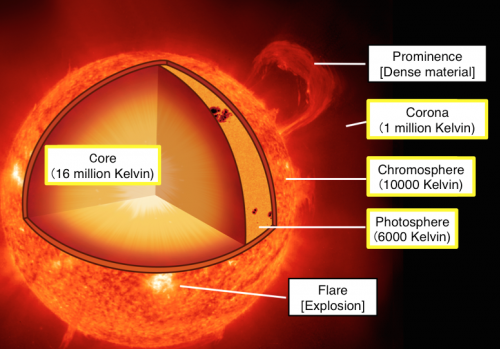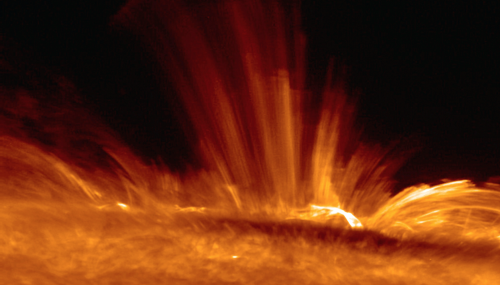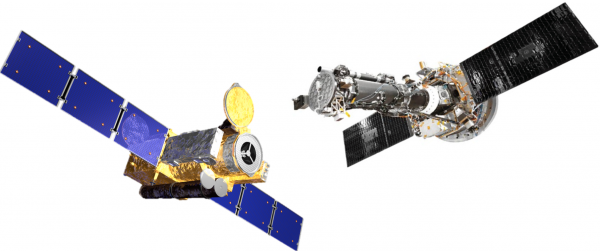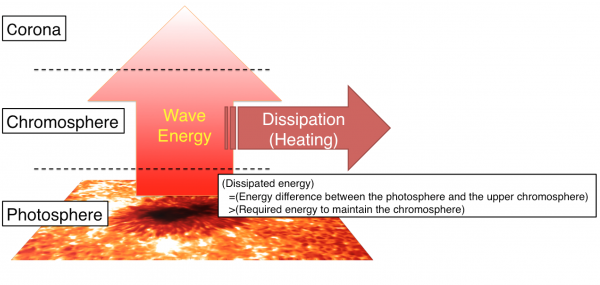A joint observation by solar observing satellites Hinode and IRIS quantitatively explores the formation of the solar chromosphere
Institute of Space and Astronautical Science / Japan Aerospace Exploration Agency (ISAS/JAXA)
Naional Astronomical Observatory of Japan (NAOJ)
Institute for Space-Earth Environmental Research (ISEE) / Nagoya University
Abstract
Although the solar energy sources are located at the core of the Sun, the temperature of the upper part of the solar atmosphere (called the chromosphere and corona) is higher than that of the visible surface, i.e. photosphere. The mechanisms that produce such a peculiar behavior are still a mystery for solar researchers. Waves, which propagate upward along the magnetic field lines and dissipate (thermalize) the energy at the upper atmosphere, are one of the candidates that would transport the energy to the chromosphere and corona. In order to verify this idea, we need to check whether the amount of energy dissipated at the upper atmosphere is sufficient for maintaining the coronal temperature or not.
A Japanese research team tried to tackle this for the first time evaluating how much energy is dissipated at the chromosphere through waves. The results show that the amount of dissipated energy is ten times larger than the required energy to maintain the chromosphere. Therefore, waves could be responsible to heat the upper chromosphere up to its present values, i.e. 10,000 Kelvin.
This discovery was found thanks to an international collaboration between Japan-US solar observing satellites. The Hinode mission revealed photospheric tiny fluctuations of the physical parameters through spectropolarimetric observations. Moreover, the IRIS (Interface Region Imaging Spectrograph) performed spectroscopic observations to derive the physical information of the upper chromosphere. The combination of these satellites made possible to evaluate the dissipated energy by comparing the energy fluxes obtained at the two atmospheric layers.
Background
Figure 1 schematically illustrates the solar structure. The upper atmospheres called the chromosphere and corona exist above the solar surface, i.e., photosphere. A peculiar behavior can be easily recognized when we focus on the temperatures of each layer; the upper atmosphere is hotter than the bottom part. Since the solar energy is created at the core of the Sun through nuclear reactions, the temperature of the solar atmosphere should decrease as we move away from the core of the Sun. However, the temperature increases in the outer atmosphere above the photosphere showing a reversal on the expected behavior. The physical origin of this temperature reversal at the outer atmosphere is still unknown and it is one of the major mysteries in solar physics, known as the chromospheric and coronal heating problems. Especially, coronal heating is closely related to the acceleration of the solar wind and, thus, understanding its physical origin is important as well from the point of view of the Sun-Earth connection.
Figure 1 Schematic drawing of the solar structure (Credit: JAXA)
Here the chromosphere is briefly introduced. Although the chromospheric temperature (10,000 Kelvin) is much lower than that of the corona (>1 million Kelvin), the energy required for maintaining the chromosphere is ten times larger than that of the corona, because the density in the chromosphere is much higher than that in the corona. Hinode has discovered that the chromosphere is fulfilled with dynamic phenomena (Figure 2), and solar researchers pay attention to these dynamic phenomena for trying to understand their implications to the heating of the corona. In other words, if we understand how the dynamic chromosphere is energized and formed, then we would be able to address the coronal heating mechanisms.
Figure 2 A Hinode view of the solar chromosphere above the solar limb
(November 2006) (Credit: NAOJ/JAXA)
One of the most important ideas for heating the upper atmosphere is the wave heating hypothesis: after waves are excited by the convective motions at the photosphere, they propagate upwardly along the magnetic field lines and dissipate the energy at the upper atmosphere. Recent observations have provided some key findings, such as [1] magneto-hydrodynamic waves really exist in the solar atmosphere, and [2] the waves dissipate their energy in the corona (Reference: http://hinode.nao.ac.jp/en/news/results/hinode-iris-and-aterui-cooperate-on-70-year-old-solar-mystery-magnetically-driven-resonance-helps-he/).
Figure 3 Schematic drawing of the mechanism for heating the upper atmosphere
by means of waves (Credit: JAXA/NAOJ)
Thus, can we declare that the chromospheric and coronal heating problems have already been solved?
The answer is NO. We need to quantitatively examine that the amount of the dissipated energy is sufficient for heating the upper atmosphere.
Details of Research
Ryuichi Kanoh (The University of Tokyo and ISAS/JAXA) and his collaborators analyzed a unique dataset of the joint Hinode-IRIS (Figure 4) observations on the umbra of a sunspot, where periodic oscillations have been well observed at the photosphere and chromosphere. They investigated high-cadence time series of signals and determined the nature of the observed waves.
The Solar Optical Telescope onboard Hinode has a spectro-polarimeter that provides time series of the low amplitude wave fluctuations at the photospheric layers. On the other hand, the IRIS satellite can measure spectral lines that form in upper layers, i.e. chromosphere, helping us to measure the physical properties of waves at these heights. By coordinating these observations, we are able to trace the evolution of waves at two atmospheric layers, i.e., photosphere and upper chromosphere, simultaneously. As shown in Figure 5, the energy deposited in the atmosphere between the two layers can be evaluated with the upward energy fluxes estimated at the two layers.
Figure 4 Hinode (Left) and IRIS (Right) satellites (Credit: NAOJ/NASA)
Figure 5 Schematic drawing of the logic for estimating the dissipated energy. The difference between the energy fluxes at the photosphere and the upper chromosphere is larger than the energy required to maintain the chromosphere. (Credit: JAXA/NAOJ)
Our evaluation has revealed that the energy of the ascending waves measured at the upper chromosphere is significantly smaller than that measured at the photosphere. Moreover, this reduction in the energy is larger than the energy required for maintaining the chromosphere suggesting that the observed waves can make a crucial contribution to the heating of the chromosphere. Observations of waves have been used so far in qualitative discussions on the mechanisms of the chromspheric heating and our analysis, based on the Hinode-IRIS coordination, adds quantitative information to these discussions.
Note that this quantitative estimation can be done thanks to an international collaboration between the Hinode and IRIS missions. The amplitude of the waves observed in the solar atmosphere is tiny but they behave dynamically. Due to the atmospheric turbulence of the Earth's atmosphere, with ground- based observations, it is extremely difficult to measure the nature of the waves. Moreover, simultaneous measurements are required at two atmospheric heights to quantitatively estimate the dissipation of the ascending waves. For these reasons, the coordinated observations between Hinode and IRIS solar missions are the only way to evaluate the dissipated energy of waves.
The method used in this research is reliable and can be also applied to estimate the amount of energy transferred to the corona. Unfortunately, none of the solar missions used in this work observe coronal lines with spectroscopy so we cannot study the properties of waves at the corona. However, future solar missions such as Solar-C would provide the opportunity for evaluating the energy flux in the corona what will enormously contribute to the understanding of the formation of the solar corona.
[Paper Information]
Title: Hinode and IRIS Observations of the Magnetohydrodynamic Waves Propagating from the Photosphere to the Chromosphere in a Sunspot
Authors: Ryuichi Kanoh (The University of Tokyo and ISAS/JAXA), Toshifumi Shimizu (ISAS/JAXA), Shinsuke Imada (Nagoya University)
Journal: The Astrophysical Journal, 831, 24, November 1, 2016 .
This research was partially supported by JSPS KAKENHI Grant Number JP25220703 (PI: S. Tsuneta).
[Supplementary explanation]
For estimating the energy carried upwardly by waves, we need to take two steps. The first one is to identify the type of waves. For example, longitudinal waves and transverse waves do not carry the same amount of energy. The second step is to measure the atmospheric physical parameters quantitatively. In this regard, spectroscopic observations are able to detect the fluctuations caused by waves in physical parameters quantitatively and accurately.
We first focus on the type of waves. In that sense, waves are known to be identified with the phase relations of the fluctuations such as the intensity, velocity and magnetic field strength. By measuring these quantities, Hinode revealed that there are dominant longitudinal (in particular : slow-mode) waves. In addition, comparison with waves observed with Hinode and IRIS suggested the leakages of the high- frequency wave components from the photosphere to the chromosphere.
Energy carried by longitudinal waves can be estimated with the density, amplitude and temperature. The amplitudes of waves can be inferred by the Doppler shift of observed spectral lines. On the other hand, the temperature of the solar plasma is estimated from the formation temperature of the spectral lines. The method for estimating the density is different between the photosphere and upper chromosphere. For the latter layer the ratio of two lines emitted by the same ion is a good indicator of the density. On the other hand, since the plasma properties are different from the upper chromosphere, this line ratio method cannot be used at the photosphere. However, since the behavior of waves depend on density, the observed intensity, velocity and magnetic field strength are used for determining the density at photospheric layers. In this way, Hinode and IRIS successfully estimated the ascending energy carried by waves at the photosphere and upper chromosphere.
[Appendix]
・Longitudinal waves and transverse wave
In a longitudinal wave, the displacement of the medium is parallel to the direction of wave propagation. On the other hand, in a transverse wave, the displacement of the medium is perpendicular to the direction of wave propagation.
With a relative velocity between an observer and a source of light, the observer see spectral lines that are shifted from their rest wavelengths. By using the Doppler shift, line-of-sight (The sun - Earth direction) velocity of the solar plasma can be investigated.
Regarding the use of images and movies on the page concerned, please visit the page here. The credits of images and movies on this page are “NAOJ/JAXA” unless explicitly stated to the contrary. Regarding images and movies on this page the credits of which are “NAOJ/JAXA”, "NAOJ/JAXA/MSU", or “NAOJ, JAXA, NASA/MSFC”, terms of use for Copyrighted Works owned by NAOJ can be applied. In using the images and movies, the credits should be given.





